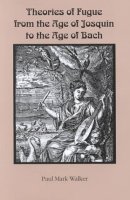|
Bach Books
Theories of Fugue from the Age of Josquin to the Age of Bach
by Paul Walker
Book
|
1 |
Theories of Fugue from the Age of Josquin to the Age of Bach |

|
|
Eastman Studies in Music Series, Vol 13 |
|
Paul Mark Walker |
|
Boydell & Brewer |
2000 |
499 pp |
Fugue, canon, counterpoint, Niedt, Mattheson, and more...
Bradley Lehman wrote:
(...)
This weekend I did some further reading about Niedt and his circle, in this book:
http://www.amazon.com/exec/obidos/tg/detail/-/1580460291/
The author, Dr Paul Walker, is one of the top experts on historical writings about counterpoint; he is also the contributor of some of the New Grove articles in that area.
For our discussion here about Niedt, the most relevant parts of his book are chapter 9 and the first part of chapter 10. He gives a survey of how Niedt's descriptions of contrapuntal forms made their way into the standard German musical dictionary in Bach's own lifetime, namely the one by Bach's own cousin (and colleague and friend: working together at least as early as 1708, Weimar days), Johann Gottfried Walther. This dictionary was the Musicalisches Lexikon (1732), and Bach himself was a sales agent for this book in Leipzig (according to the Walther entry in Oxford Composer Companions: J S Bach). Walker also describes the other music dictionaries of that period, goes through their definitions of contrapuntal forms, and shows how several of them rely directly on Niedt's work.
Walker then continues with the reception history of Niedt's work, and Mattheson's republications and updates of Niedt. He shows how Mattheson defended himself, and defended Niedt, against challenges from gentlemen named Buttstedt and Bokemeyer. Bokemeyer, especially, was upset at the way Niedt and Mattheson had a low opinion of canon as a technique; but Mattheson rose to the challenge. Walker also presents opinions by a Johann Christoph Schmidt of Dresden, along with some other characters in these early 18th-century debates. [My main point here is: Niedt's work, both on its own and in Mattheson's promotions of it, was a standard reference and people were talking about it and publishing articles about it; there is no way that Bach would not have been aware of these buzzes in musical/theoretical circles...especially as a cousin of Walther, and as a member of Mizler's society. The raison d'etre of Mizler's society, after all, was to discuss exactly this type of stuff: the musical sciences. And Walker notes that Bach was one of "the most historically-aware composers" of his time, which is of course common knowledge anyway: Bach knew very well what theoretical and practical forms he was working with, and he knew the published writings in this field.]
(...)
Bradley Lehman wrote (April 15, 2003):
I've set up a web page of excerpts from the book Theories of Fugue from the Age of Josquin to the Age of Bach (2000) by Paul Walker (with the author's permission, of course). The book is scheduled for a reprint this autumn: I have linked to the details about that, from the publisher.
Walker shows the history of contrapuntal terminology: fugue, ricercar, canzona, fantasia, capriccio, prelude, toccata, fantasy, canon, etc.... Some of the major figures there (writers of treatises and musical dictionaries) were Praetorius, Kircher, Friedrich Niedt, Johann Mattheson, Johann Joseph Fux, Sebastien de Brossard, Johann Jakob Walther (Bach's cousin), etc.: codifying the types of counterpoint. I've put up Walker's Chapter 9, about the German lexicographical texts of the 17th and 18th centuries.
Another of Walker's chapters (10, also excerpted here) covers the reception history of the writings of Niedt and Mattheson: and Mattheson's defense in print against challenges by Buttstedt, Bokemeyer, and others. These were the "hot" theoretical topics in Bach's Germany...the musical forms, their use, their disuse, arguments about the role of canon and fugue on their own or in larger compositions, etc.
This is the type of theoretical stuff that Bach and the other members of Mizler's society sat around discussing: the musical sciences. Imagine Bach and his buddies around a table of beers, arguing about different types of canon and fugue! :)
http://www.vaix.net/~bpl/walker/walker.htm
|